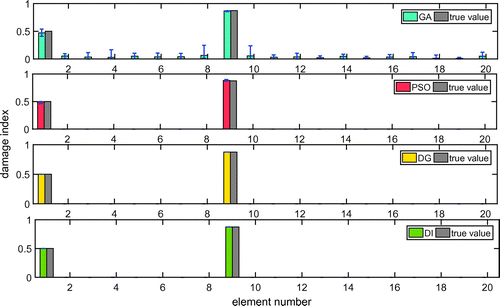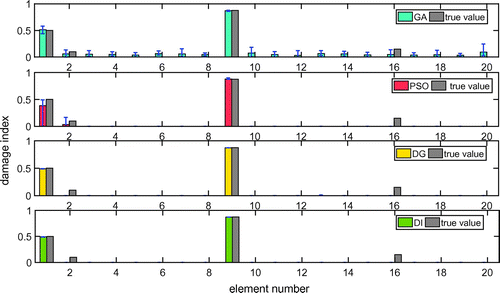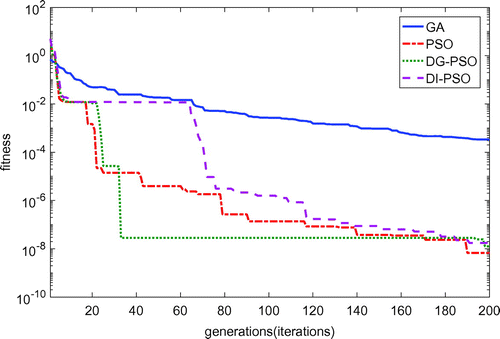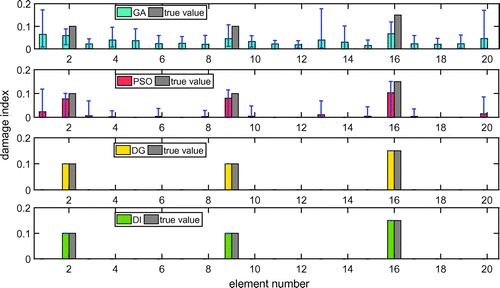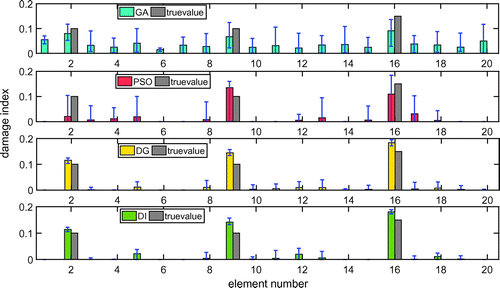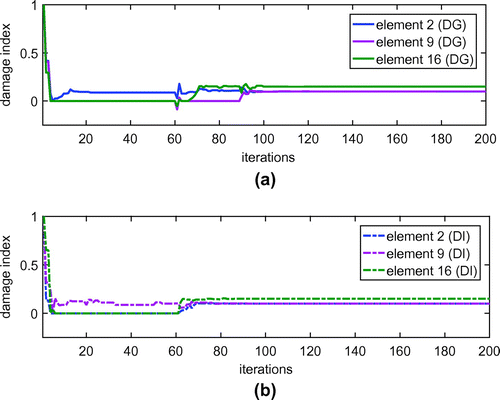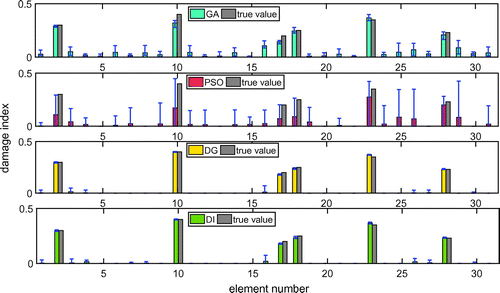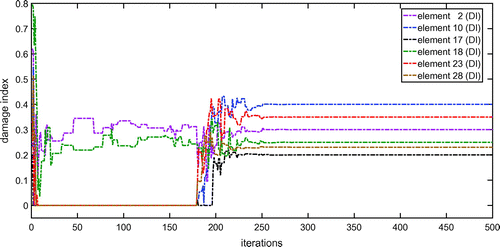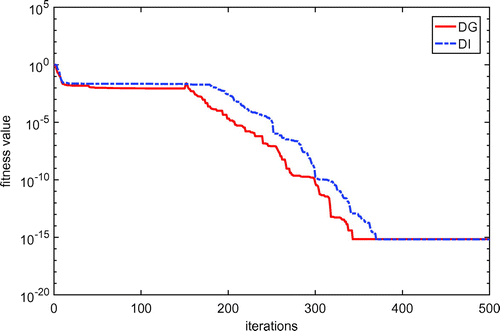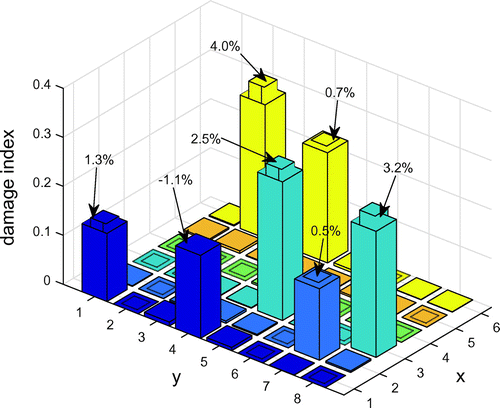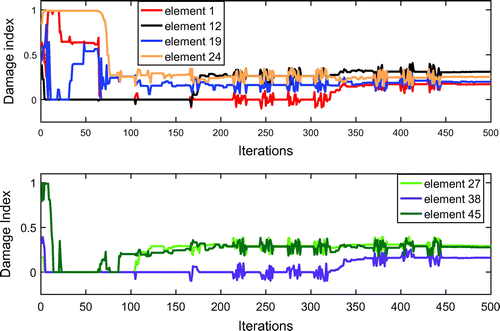 ?Mathematical formulae have been encoded as MathML and are displayed in this HTML version using MathJax in order to improve their display. Uncheck the box to turn MathJax off. This feature requires Javascript. Click on a formula to zoom.
?Mathematical formulae have been encoded as MathML and are displayed in this HTML version using MathJax in order to improve their display. Uncheck the box to turn MathJax off. This feature requires Javascript. Click on a formula to zoom.Abstract
An approach based on an improved particle swarm optimization (PSO) algorithm is proposed for structural damage detection in this study. A disturbance is introduced in the evolution process to avoid the occurrence of premature. The present algorithm focuses on the mutation of global or individual best known positions to guide the swarm to escape from the local minimum. The feasibility and robustness of the modified PSO are verified by three different structures, including a beam, a truss and a plate. The results show that the method is efficient and effective for structural damage identification when measurement noise is considered.
AMS Subject classification:
1. Introduction
In the last few decades, techniques based on vibration response have been extensively developed for structural damage identification and health monitoring. Local damages cause changes in structural physical properties, mainly in stiffness and damping at damaged locations. These changes will result in the changes of structural dynamic characteristics, such as natural frequencies and mode shapes, etc. There are abundant excellent literatures in the field of vibration-based damage detection. Doebling et al. [Citation1] presented a comprehensive review of the damage detection methods by examining changes in the dynamic responses of a structure. Housner et al. [Citation2] provided a summary on the most-advanced techniques in control and health monitoring in civil engineering structures. The progress on structural condition monitoring and damage identification in the aspect of composite structures has been reviewed by Zou et al. [Citation3].
Plenty of achievements have been obtained on damage detection in both frequency domain and time domain. Cawley and Adams [Citation4], Narkis [Citation5] localized structure damages using measured natural frequencies. Pandey et al. [Citation6] conducted damage identification by observing the changes in curvature mode shapes. Besides, many researchers made excellent studies on damage detection using vibration data in frequency domain [Citation7–12]. Damage detection methods in time domain have been developed rapidly in recent years. A non-destructive time domain approach to identify the local structural damage was proposed by Cattatius and Inman [Citation13]. By observing the features of dynamic response sensitivity, Lu and Law [Citation14] proposed a response sensitivity-based method to identify structural damage. This method can effectively identify both the locations and extents of damages through the finite-element model updating. This approach was further developed to identify both local damages and the input force and the crack parameters in beam structures [Citation15,16]. Nilson et al. [Citation17] proposed a parameter-based mathematical morphology using vibration signal data. Tao et al. [Citation18] put forward a vibration-based detection for structural connections using incomplete modal data by Bayesian approach and model reduction technique. Chang and Kim [Citation19] conducted a field experiment on an actual damaged steel truss bridge to identify modal parameters and damages. Zhang et al. [Citation20] presented a damage detection approach for bridge structures under moving loads based on the phase trajectory change of multi-type vibration measurements.
The usual model-based damage detection methods focus on minimizing an objective function, which is expressed as the discrepancies between the vibration data obtained by modal testing and those computed from the analytical data. Traditional optimization methods are usually gradient-based [Citation21] and these gradient-based methods may lead to local minima when the objective function is highly non-linear. An optimization technique with strong searching ability is needed to obtain more reliable solution. In these years, artificial swarm intelligence algorithms are quite popular in solving optimization problems including damage detection due to their strong global searching abilities [Citation22–29]. Genetic algorithm (GA) as a classic global optimization method has been widely used for structural damage detection [Citation30–32]. Many improved and enhanced versions of GA have also been proposed and meticulously studied. He and Hwang [Citation33] put forward an adaptive real-parameter simulated annealing GA to identify damage in beam-type structures. A hybrid neural genetic algorithm for damage assessment using data of structural static and dynamic behaviour was adopted by Sahoo and Maity [Citation34]. Kokot and Zenbaty [Citation35] identified damage for 3-D frames based on genetic algorithm and Levenberg-Marquardt local search.
Apart from GA, particle swarm optimization (PSO) [Citation36–38] is a novel heuristic algorithm and has been developed recently. PSO is a population-based global optimization technique with many similarities with genetic algorithm. PSO has attracted great attentions in the past few years because of its simplicity, universality and outstanding performance. It has been applied into a large amount of real-world optimization problems [Citation39–41]. Comparing to GA or other optimization algorithms, PSO requires fewer number of function evaluations and it is more simple and efficient [Citation42–44]. The principal disadvantage of PSO is its high possibility of premature convergence, similar to other algorithms. Hence, many improvements on the original PSO have been studied by many researchers. Chen and Zhao [Citation42] developed a PSO with adaptive population size to enhance the overall performance of PSO. Nickabadietal [Citation43] presented a novel PSO with adaptive inertia weight. Sabatetal [Citation44] made a research on an integrated learning PSO to enhance the convergence and quality of solution.
Structural damage detection method based on PSO has been explored by some researchers. Kang et al. [Citation45] proposed an immunity-enhanced PSO to obtain more accurate damage identification results with a quicker convergence speed. Seyedpoor used a multi-stage particle swarm optimization in structural damage detection [Citation46]. He later applied PSO in the second step of two-step method to identify the damage extents [Citation47]. Nouri Shirazi et al. utilized an adaptive multi-stage optimization method based on modified particle swarm algorithm to identify structural damages [Citation48]. Begambre and Laier [Citation49] presented a novel strategy for the control of the particle swarm optimization (PSO) parameters based on the Nelder–Mead algorithm (Simplex method) to enhance the stability and confidence of PSO. Sandesh and Shankar [Citation50] found that a hybrid of particle swarm and genetic algorithm for structural damage detection would be far superior than pure PSO and GA in convergence and accuracy. Jena and Parhi [Citation51] proposed a modified PSO to identify cracks of cantilever beams. Kaveh and Maniat [Citation52] applied Magnetic Charged System Search (MCSS) and PSO to the problems of damage detection using frequencies and mode shapes of structures. Gerist and Maheri [Citation53] investigated multi-stage approach for structural damage detection problem using basis pursuit and PSO.
In this paper, a disturbed PSO (DPSO) is proposed for structural damage identification, in which a disturbance is introduced in the original PSO to avoid the whole swarm from sinking into local optimization. Unlike the improved methods raised by some literatures (say, [Citation45]) focusing on the combinations of characteristics of PSO and some other optimization algorithms, the DPSO pays attentions on the two key factors determining the motions of each particle. It will help the whole swarm escape from the local minimum.
2. Methodology for vibration-based damage identification
2.1. Parameterization of local damage
Without loss of generality, the eigenvalue equation for a finite-element model of an intact structure can be expressed
(1)
(1)
where and
are the structural stiffness matrix and mass matrix, respectively. ωj is the jth natural frequency and ϕj is the corresponding mode shapes.
When a damage occurs in a structure, it will cause the loss in the local stiffness, but the loss in mass is usually neglected. The damaged stiffness of a structure with nel elements can be evaluated by a set of damage parameters di (i = 1, 2, …, nel) in the form of following equation
(2)
(2)
where is the stiffness matrix of the damaged system, and
presents the ith elemental stiffness matrix. The parameter di with value range between 0 and 1 refers to the damage extent of the ith element. di = 0 indicates no damage while di = 1 represents the complete damaged status. Therefore, detection of the local damages in a structure is equivalent to quantify the values of the damage parameter vector {d}.
2.2. Objective function in frequency domain
It is known that the changes in structure properties will lead to changes in the dynamic characteristics, such as natural frequencies and mode shapes. In the context of damage detection, the task is to minimize the objective function using the discrepancies between the measured data and the calculated ones.
Making use of the modal parameters including natural frequencies and modal assurance criteria (MAC) in frequency domain, the objective function for damage detection is defined as [Citation27]
(3)
(3)
where wωj and wϕj are weight factors corresponding to jth natural frequency and jth MAC, respectively. NF and NM are the numbers of frequencies and mode shapes used in calculation, respectively.
The mathematical expression of the differences of natural frequencies in Equation (Equation3(3)
(3) ) is expressed as
(4)
(4)
where and
are the jth calculated and measured natural frequencies, respectively.
And the expression of MAC in jth mode in Equation (Equation3(3)
(3) ) is
(5)
(5)
where and
are the jth calculated and measured mode shapes respectively. Equation (5) indicates that value of MAC is 1 when the calculated mode shape equals to the measured one.
It can be observed that Equation (Equation3(3)
(3) ) is a function with respect to the damage index{d}. Given a particular damage condition, if a set of damage index enables the objective function to achieve the minimum (theoretically, it is zero), the damage index represents the true structural damage status.
3. A brief introduction to PSO
PSO is inspired by a model of social interactions in a group of independent animals seeking for food. An animal in PSO is called a particle. Each particle in PSO makes its motion with a velocity influenced by its own movement experience and the one shared by its companions in the whole swarm of population N. Each particle is treated dimensionless in the D-dimensional search space and denoted as . The lower and upper bounds of the jth dimension is lj and uj.The previous best position of ith particle is taken as
, while the best position in the whole swarm history is recorded as
. The velocity for the motion of particle i is
. In each generation t, ith particle is manipulated by the following equations according to Shi and Eberhart [Citation54]
(6)
(6)
(7)
(7)
where c1 and c2 are two positive constants, while r1 and r2 are random number between 0 and 1, w is an inertia term, or a weighting factor.
It is suggested that a suitable selection of w will provide a balance between local and global explorations. The most common selection of w is that it decreases from 0.9 to 0.4 with the expression below
(8)
(8)
where wmax and wmin are initial and final weight, respectively, with T as the maximum number of allowable generations. Meanwhile, a simple treatment is taken to boundary conditions as
(9)
(9)
where ld = 0 and ud = 0.99 is the lower bound value and upper bound value for the damage extent, respectively. In the context of damage detection, ld = 0 means intact status of an element, while ud = 0.99 means the totally destroyed of the element.
4. The improved PSO
As mentioned above, the disadvantage of the original PSO is its premature convergence, especially for multimodal functions [Citation55]. Unfortunately, the fitness function for damage detection based on PSO is a complicated and multimodal. In this study, concentration is paid on two decisive factors on each particle movement, namely, and
in Equation (Equation6
(6)
(6) ).
After certain number of iterations, the result starts to converge, a check is required to make on the possibility of premature convergence.
(10)
(10)
where iter means the current iteration, a and b are two constants between 0 and 1 to determine the time of starting and ending of the disturbance. ε and δ are two small tolerances. If Equation (Equation10(10)
(10) ) is satisfied, it can be confirmed that premature convergence occurs. In such case, a disturbance is introduced on either
or
. But when the disturbance is introduced on
and
simultaneously, it will lead to wrong identified results as the disturbance is too strong. When the disturbance is introduced on
, it is denoted as DG, while on
, denoted as DI. The disturbance equations are given below
(11)
(11)
or(12)
(12)
c3 is the magnitude of disturbance, r3 is a random number in the range [−1, 1]. The superscript ′ denotes the disturbed value of current iteration step. Particles in swarms obtain their motions by following the disturbed or
. It is worthy mentioned that during the disturbance the dimensional value is allowed to exceed the boundary. The effect of disturbance from Equations (11) or (12) on the convergence is almost the same, which will be illustrated in the numerical simulations.
The steps for damage identification based on DPSO are listed as follows.
Step 1: Initialize the population (generate a random population of N solutions) in the search space.
Step 2: For each particle i ∊ N, calculate its fitness value by Equation (Equation3
(3)
(3) ) using Equations (1) and (2).
Step 3: Update the best position of individual i, updating the best position of whole swarm.
Step 4: If Equation (Equation10
(10)
(10) ) is satisfied, conduct disturbance according to Equation (11) or Equation (12).
Step 5: Evolve each particle according to Equations (Equation6
(6)
(6) ) and (Equation7
(7)
(7) ).
Step 6: Treat the boundary using Equation (Equation9
(9)
(9) ).
Step 7: Repeat Steps 2–6 until the maximum number of iteration is reached.
5. Numerical simulation
5.1. Parameters setting for DPSO
The parameter w in Equation (Equation8(8)
(8) ) is set to decrease linearly from 0.9 to 0.4 according to Shi [Citation54]. c1 and c2 are both set to be 2.0 in Equation (Equation6
(6)
(6) ). The population N is taken as 100. wωj and wϕj in Equation (Equation3
(3)
(3) ) are both set to be 1. The other parameters for DPSO are listed in Table . Original PSO and GA are introduced as comparison algorithms. Ten runs are performed for each algorithm in the following damage cases. These 4 algorithms share the same max iteration number in each run, which are 200 for the beam (same as reference literature [Citation45]) and 500 for the truss and plate.
Table 1. Parameter values for DPSO.
To simulate measurement noise, the natural frequencies are contaminated with 1% noise and 10% noise is added to the modal displacement for all the cases with noise. The mathematic expressions of added noise are listed below
(13)
(13)
(14)
(14)
where the overbars mean noise-polluted data. γω and are uniformly distributed random number between −1 and 1. ρω, ρΦ are the levels of the random noise. The subscripts ‘ij’ of
and ϕij are the mode shape components of the jth mode at ith degree of freedom.
is the largest absolute value of component in the jth mode shape.
5.2. A simply supported beam
A simply supported beam studied by Kang et al. [Citation45] is used as an example. The geometry of the beam is shown in Figure . The total number of elements and nodes are 20 and 21, respectively. Properties of the material are Young’s modulus E = 70 GPa, mass density and Poisson ratio μ = 0.33. Two damage cases in [Citation45] are studied and the first three natural frequencies and modes shapes are utilized in these two cases for comparison.
5.2.1. Damage case 1
This case presents multiple severe damage cases with the assumption that element 1 and element 9 has 50 and 87.5% reduction in elemental stiffness, respectively.
Original PSO and GA (GA function in MATLAB® is utilized here) are employed here as comparison to illustrate the effectiveness, efficiency and accuracy of proposed algorithms either without noise or with identical noise. Damage detection results are shown in Figure . The colourized bars represent the averaged results of 10 runs for each algorithm, while the vertical segment line at each bar shows the maximum and minimum in 10 runs, respectively. Grey bars are true values. It can be observed that no algorithm suffers premature convergence in noise-free condition. The results from both original and improved PSO methods are more accurate and less time-consuming than GA, which has multiple small false alarms. Figure shows that when frequencies and mode shapes data are polluted by noise, DG-PSO and DI-PSO still obtain quite desirable identification results in each run. Damage extents are identified with wrong results in some runs when the original PSO is used, it maybe duo to premature convergence. GA gives similar performance compared with that in noise-free condition. The identified results of damaged elements are listed in Table . The evolutionary processes of fitness values of these four algorithms are illustrated in logarithmic form in Figure . It can be observed that in the respect of optimization problems of damage detection, in absence of premature convergence, PSO-based methods are superior to GA in convergence precision.
Table 2. Identified values of damaged elements and relative errors of different structures with noise.
5.2.2. Damage case 2
In this case it is assumed that element 2 and element 9 have both 10% reduction in stiffness meanwhile element 16 has 15%, i.e. d2 = 0.1, d9 = 0.1 and d16 = 0.15. We consider both the conditions with and without noise. In this case, the number of damages increases while the damage extents decrease compared with case 1.
| (1) | Comparison with original PSO and GA | ||||
Damage detection results in noise-free condition are shown in Figure . In noise-free conditions, the identified results from both improved methods converge to the true value accurately in each run and all 10 runs. However, GA and original PSO cannot perform so well. GA locates damages with severe false alarms in each run which leads to poor performance. The performance for PSO is not robust, i.e. it can identify the damages correctly in some runs, while it cannot in some runs due to premature convergence.
In noise-contaminated condition, Figure and Table show the damage detection result from different methods. The identified results from DG-PSO and DI PSO are more close to true values with less and smaller false alarms than those from GA and PSO in the same noise-polluted condition. What’s more, these two improved PSO methods perform more steadily in each run than GA and PSO, which can be observed from the lengths of vertical segments of each element in Figure .
It can be found out that in this case, the probability of premature convergence rises compared with case 1. It probably is caused by the dramatically reduction on damage severity and increase on the number of damaged elements, which enhances identification difficulty. Figures and demonstrate the effectiveness of damage identification using proposed methods which enhance the ability of preventing premature convergence.
| (2) | Analysis of DG-PSO and DI-PSO | ||||
The characteristics of DG-PSO and DI-PSO should be analysed here with the noise-free condition taken as example. One run is selected as representative to show the evolutionary processes from these two algorithms of damaged elements, i.e. element 2, element 9 and element 16, which are illustrated in Figure . It can be observed that, on one hand, disturbance helps elements 9 and 16 in DG, which are stuck in the wrong values due to premature convergence before, to escape from local minima and re-find the right values. On the other hand, element 2, which has found the right value before disturbance, is not affected by the subsequent disturbance.
Similarity can be found in DI. Element 2 and element 16 in DI fail to locate the true values before the first 60 steps. However, disturbance leads the elements to find true values in subsequent iterations. Element 9, like element 2 in DG, is not influenced by the disturbance. Figure indicates that the final result will return to the true value regardless of either disturbance method, if the right value has been already found before disturbance.
The evolutionary processes of logarithmic best fitness values of both DG and DI are illustrated in Figure . As best fitness value is obtained from Pg at each iteration, two small peaks in DG line denote the occurrence of disturbances. The final converged best fitness values of both DG and DI are smaller than 10−7, which shows the robustness of proposed methods. It can also be observed from Figures that DG-PSO and DI-PSO share the equivalent ability of leading the whole population to re-find the global optimization value in case of prematurity.
5.3. A truss structure
A 31-bar truss shown in Figure is studied. The length of each exterior bar is 1 m, and length of interior bar is 1.41 m. The section area of each bar is . Properties of the material are Young’s modulus
, and mass density
. The total number of elements and nodes is 31 and 14, respectively. First five frequencies and mode shapes are utilized in this case. Six local damages are assumed to locate at the 2nd, 10th, 17th, 18th, 23rd and 28th elements, with a reduction in each stiffness of 30, 40, 20, 25 35 and 23%, respectively.
In this case, the finite-element number, i.e. the dimension of each particle increases compared with the beam above as well as the number of damaged elements.
| (1) | Comparisons with GA and PSO | ||||
Comparisons with GA and PSO are performed again to illustrate the effectiveness and superiority of proposed methods. Figure shows the damage detection results in the condition without noise. It’s not difficult to find out that both GA and PSO fail to identify the damages accurately. Fortunately, due to disturbance processes, accurate identification results are obtained from both DG-PSO and DI-PSO without any false alarm in each run. The identification results in the noise-contaminated condition are illustrated in Figure . There are still several misidentifications in GA and PSO. DG-PSO and DI-PSO give global optimization results without any exception, whose identified results are detailed in Table . Figures and illustrate that when the optimization problems become more complicated, GA and PSO methods are more likely to suffer premature convergence.
| (2) | Analysis of DG-PSO and DI-PSO | ||||
One run out of 10 is selected as representative to illustrate the evolutionary processes of damaged elements using both DG-PSO and DI-PSO, which can be viewed in Figures and . It is obvious that element 2, 17, 28 in DG, as well as element 10, 17, 28 in DI suffer from prematurity before disturbances, which help these elements to return to the true values subsequently. The curve of fitness values from both algorithms are illustrated in Figure . Again, Figures – provide the evidences of effectiveness, efficiency and robustness of two proposed methods. Both disturbance methods share the equivalent performances of escaping from premature values and re-identify the true values correctly.
5.4. A four-edge simply supported plate
Figure demonstrates a thin plate with four edges simply supported as a simulation study case with its dimension of 3 m 4 m 0.1 m. The physical material properties of the plate are: Young’s modulus , mass density
and Poisson’s ratio υ = 0.3. In the finite element, the plate was discretized into 6 × 8 4-node Kirchhoff plate elements. Seven local damages are assumed to locate at the 1st, 12th, 19th, 24th, 27th, 38th and 45th elements, with a reduction in each stiffness of 15, 30, 16, 23, 30, 15 and 28%, respectively. The first 10 frequencies and mode shapes are used in the identification. As DI and DG share the equivalent ability in achieving damage detection results, DI is performed only as representative to illustrate the identified damage index.
Figure 15. Sketch of a four-edge simply supported plate ((1), (2), …, (63) denote node number of the FEM; 1, 2, … , 48 denote element number) (Dimensions not scaled).

In noise-free condition, damage index converges to right value correctly in each run. The average result of damage detection of 10 runs in noise-polluted condition is shown in Figure . The slenderer bars represent true values, while the arrow tests are the relative errors. Figure illustrates the process of evolution of damaged indices of one run in noise condition, which indicates that sufficient numbers of disturbances are quite necessary for structure with comparatively large numbers of finite elements. This case proves that the DPSO can be applied in comparatively complicated structures.
6. Conclusions
Damage detection approach based on an improved PSO using vibration data is proposed. A disturbance process is introduced when the premature convergence appears in the early generations of calculation. Disturbance helps particles escape from local minimum. And three different structures are studied to illustrate the robustness, effectiveness and efficiency of the proposed method. The proposed disturbed PSO can be utilized in different fields of optimization.
Funding
This work was supported by the National Natural Science Foundation of China [grant number 11572356]; Guangdong Province Natural Science Foundation [grant number 2015A030313126]; and the Guangdong Province Science and Technology Program [grant number 2016A020223006], [grant number 2016B090918038].
Disclosure statement
No potential conflict of interest was reported by the authors.
Acknowledgements
This work is supported by the National Natural Science Foundation of China (11572356), Guangdong Province Natural Science Foundation (2015A030313126) and the Guangdong Province Science and Technology Program (2016A020223006, 2016B090918038). Such financial aids are gratefully acknowledged.
Notes
This work was done in Sun Yat-sen University.
References
- Doebling SW, Farrar CR, Prime MB. A summary review of vibration-based damage identification methods. Shock Vib Digest. 1998;30(2):91–105.10.1177/058310249803000201
- Housner GW, Bergman LA, Caughey T, et al. Structural control: past, present, and future. J Eng Mech. 1997;123(9):897–971.10.1061/(ASCE)0733-9399(1997)123:9(897)
- Zou Y, Tong L, Steven G. Vibration-based model-dependent damage (delamination) identification and health monitoring for composite structures – a review. J Sound Vib. 2000;230(2):357–378.10.1006/jsvi.1999.2624
- Cawley P, Adams R. The location of defects in structures from measurements of natural frequencies. J Strain Anal Eng. 1979;14(2):49–57.10.1243/03093247V142049
- Narkis Y. Identification of crack location in vibrating simply supported beams. J Sound Vib. 1994;172(4):549–558.10.1006/jsvi.1994.1195
- Pandey A, Biswas M, Samman M. Damage detection from changes in curvature mode shapes. J Sound Vib. 1991;145(2):321–332.10.1016/0022-460X(91)90595-B
- Rizos P, Aspragathos N, Dimarogonas A. Identification of crack location and magnitude in a cantilever beam from the vibration modes. J Sound Vib. 1990;138(3):381–388.10.1016/0022-460X(90)90593-O
- Ratcliffe CP. Damage detection using a modified Laplacian operator on mode shape data. J Sound Vib. 1997;204(3):505–517.10.1006/jsvi.1997.0961
- Wu D, Law S. Model error correction from truncated modal flexibility sensitivity and generic parameters: Part I – simulation. Mech Syst Signal Pr. 2004;18(6):1381–1399.10.1016/S0888-3270(03)00094-3
- Chatterjee A. Structural damage assessment in a cantilever beam with a breathing crack using higher order frequency response functions. J Sound Vib. 2010;329(16):3325–3334.10.1016/j.jsv.2010.02.026
- Lim TW. Structural damage detection using modal test data. AIAAJ. 1991;29(12):2271–2274.
- Shi ZY, Law SS, Zhang LM. Structural damage localization from modal strain energy change. J Sound Vib. 1998;218(5):825–844.10.1006/jsvi.1998.1878
- Cattarius J, Inman D. Time domain analysis for damage detection in smart structures. Mech Syst Signal Pr. 1997;11(3):409–423.10.1006/mssp.1996.0086
- Lu ZR, Law SS. Features of dynamic response sensitivity and its application in damage detection. J Sound Vib. 2007;303(1–2):305–329.10.1016/j.jsv.2007.01.021
- He ZY, Lu ZR. Time domain identification of multiple cracks in a beam. Struct Eng Mech. 2010;35(6):773–789.10.12989/sem.2010.35.6.773
- Lu XB, Liu JK, Lu ZR. A two-step approach for crack identification in beam. J Sound Vib. 2013;332(2):282–293.10.1016/j.jsv.2012.08.025
- Barbieri N, Barbieri R, Silva HAT. A methodology for identification of damage in beams. Inverse Pro Sci Eng. 2016;24(3):482–503.
- Yin T, Jiang QH, Yuen KV. Vibration-based damage detection for structural connections using incomplete modal data by Bayesian approach and model reduction technique. Eng Struct. 2017;132:260–277.10.1016/j.engstruct.2016.11.035
- Chang KC, Kim CW. Modal-parameter identification and vibration-based damage detection of a damaged steel truss bridge. Eng Struct. 2016;122:156–173.10.1016/j.engstruct.2016.04.057
- Zhang WW, Li J, Hao H, et al. Damage detection in bridge structures under moving loads with phase trajectory change of multi-type vibration measurements. Mech Syst Signal Pr. 2017;87:410–425.10.1016/j.ymssp.2016.10.035
- Hao H, Xia Y. Vibration-based damage detection of structures by genetic algorithm. J Comput Civil Eng. 2002;16(3):222–229.10.1061/(ASCE)0887-3801(2002)16:3(222)
- Kang F, Li J. Artificial bee colony algorithm optimized support vector regression for system reliability analysis of slopes. J Comput Civil Eng. 2015;30(3):04015040.
- Kang F, Xu Q, Li J. Slope reliability analysis using surrogate models via new support vector machines with swarm intelligence. Appl Math Model. 2016;40(11–12):6105–6120.10.1016/j.apm.2016.01.050
- Kang F, Li JS, Li JJ. System reliability analysis of slopes using least squares support vector machines with particle swarm optimization. Neurocomputing. 2016;209:46–56.10.1016/j.neucom.2015.11.122
- Xu HJ, Ding ZH, Lu ZR, et al. Structural damage detection based on chaotic artificial bee colony algorithm. Struct Eng Mech. 2015;55(6):1223–1239.10.12989/sem.2015.55.6.1223
- Li S, Lu ZR. Multi-swarm fruit fly optimization algorithm for structural damage identification. Struct Eng Mech. 2015;56(3):409–422.10.12989/sem.2015.56.3.409
- Ding ZH, Huang M, Lu ZR. Structural damage detection using artificial bee colony algorithm with hybrid search strategy. Swarm Evolution Comput. 2016;28:1–13.10.1016/j.swevo.2015.10.010
- Xu HJ, Liu JK, Lu ZR. Structural damage identification based on cuckoo search algorithm. Adv Struct Eng. 2016;19(5):849–859.10.1177/1369433216630128
- Ding ZH, Lu ZR, Liu JK. Improved Artificial Bee Colony Algorithm for crack identification in beam using natural frequencies only. Inverse Probl Sci Eng. 2017;25(2):218–238.10.1080/17415977.2016.1160391
- Vakil-Baghmisheh M-T, Peimani M, Sadeghi MH, et al. Crack detection in beam-like structures using genetic algorithms. Appl Soft Comput. 2008;8(2):1150–1160.10.1016/j.asoc.2007.10.003
- Chou JH, Ghaboussi J. Genetic algorithm in structural damage detection. Comput Struct. 2001;79(14):1335–1353.10.1016/S0045-7949(01)00027-X
- Buezas FS, Rosales MB, Filipich CP. Damage detection with genetic algorithms taking into account a crack contact model. Eng Fract Mech. 2011;78(4):695–712.10.1016/j.engfracmech.2010.11.008
- He RS, Hwang SF. Damage detection by an adaptive real-parameter simulated annealing genetic algorithm. Comput Struct. 2006;84(31):2231–2243.10.1016/j.compstruc.2006.08.031
- Sahoo B, Maity D. Damage assessment of structures using hybrid neuro-genetic algorithm. Appl Soft Comput. 2007;7(1):89–104.10.1016/j.asoc.2005.04.001
- Kokot S, Zembaty Z. Damage reconstruction of 3D frames using genetic algorithms with Levenberg–Marquardt local search. Soil Dyn Earthq Eng. 2009;29(2):311–323.10.1016/j.soildyn.2008.03.001
- Kennedy J, Eberhart RC. Particle swarm optimization. Proceedings of IEEE international conference on neural networks. Perth; 1995.
- Eberhart RC, Kennedy J. A new optimizer using particle swarm theory. Proceedings of the sixth international symposium on micro machine and human science. New York, NY; 1995.
- Poli R, Kennedy J, Blackwell T. Particle swarm optimization. Swarm Intell-US. 2007;1(1):33–57.10.1007/s11721-007-0002-0
- Kalyani S, Swarup KS. Classifier design for static security assessment using particle swarm optimization. Appl Soft Comput. 2011;11(1):658–666.10.1016/j.asoc.2009.12.026
- Kuo RJ, Chao CM, Chiu Y. Application of particle swarm optimization to association rule mining. Appl Soft Comput. 2011;11(1):326–336.10.1016/j.asoc.2009.11.023
- Ganguly S, Sahoo N, Das D. Mono-and multi-objective planning of electrical distribution networks using particle swarm optimization. Appl Soft Comput. 2011;11(2):2391–2405.10.1016/j.asoc.2010.09.002
- Chen D, Zhao CX. Particle swarm optimization with adaptive population size and its application. Appl Soft Comput. 2009;9(1):39–48.10.1016/j.asoc.2008.03.001
- Nickabadi A, Ebadzadeh MM, Safabakhsh R. A novel particle swarm optimization algorithm with adaptive inertia weight. Appl Soft Comput. 2011;11(4):3658–3670.10.1016/j.asoc.2011.01.037
- Sabat SL, Ali L, Udgata SK. Integrated learning particle swarm optimizer for global optimization. Appl Soft Comput. 2011;11(1):574–584.10.1016/j.asoc.2009.12.016
- Kang F, Li J-j, Xu Q. Damage detection based on improved particle swarm optimization using vibration data. Appl Soft Comput. 2012;12(8):2329–2335.10.1016/j.asoc.2012.03.050
- Seyedpoor SM. Structural damage detection using a multi-stage particle swarm optimization. Adv Struct Eng. 2011;14(3):541–557.
- Seyedpoor SM. A two stage method for structural damage detection using a modal strain energy based index and particle swarm optimization. Int J Nonlin Mech. 2012;47(1):1–8.10.1016/j.ijnonlinmec.2011.07.011
- Nouri Shirazi MR, Mollamahmoudi H, Seyedpoor SM. Structural damage identification using an adaptive multi-stage optimization method based on a modified particle swarm algorithm. J Optimiz Theory App. 2014;160(3):1009–1019.10.1007/s10957-013-0316-6
- Begambre O, Laier JE. A hybrid particle swarm optimization–simplex algorithm (PSOS) for structural damage identification. AdvEngSoftw. 2009;40(9):883–891.
- Sandesh S, Shankar K. Application of a hybrid of particle swarm and genetic algorithm for structural damage detection. Inverse Pro Sci Eng. 2010;18(7):997–1021.10.1080/17415977.2010.500381
- Jena PK, Parhi DR. A modified particle swarm optimization technique for crack detection in cantilever beams. Arabian J Sci Eng. 2015;11:1–10.
- Kaveh A, Maniat M. Damage detection based on MCSS and PSO using modal data. Smart Struct Syst. 2015;15(5):1253–1270.10.12989/sss.2015.15.5.1253
- Gerist S, Maheri MR. Multi-stage approach for structural damage detection problem using basis pursuit and particle swarm optimization. J Sound Vib. 2016;384:210–226.10.1016/j.jsv.2016.08.024
- Shi YH, Eberhart R. A modified particle swarm optimizer. Proceedings of Evolutionary Computation Proceedings, IEEE World Congress on Computational Intelligence. Anchorage (AK): IEEE; 1998. p. 69–73.
- Seo J-H, Im C-H, Heo C-G, et al. Multimodal function optimization based on particle swarm optimization. IEEE T Mag. 2006;42(4):1095–1098.10.1109/TMAG.2006.871568


